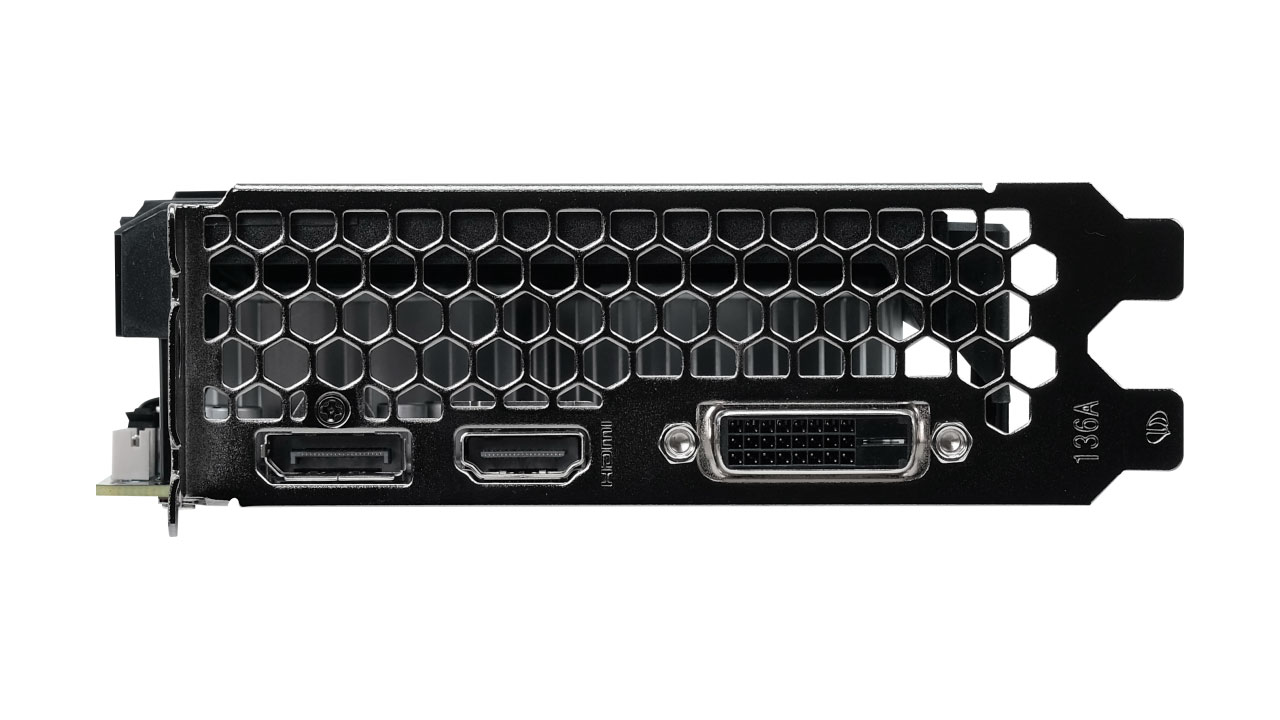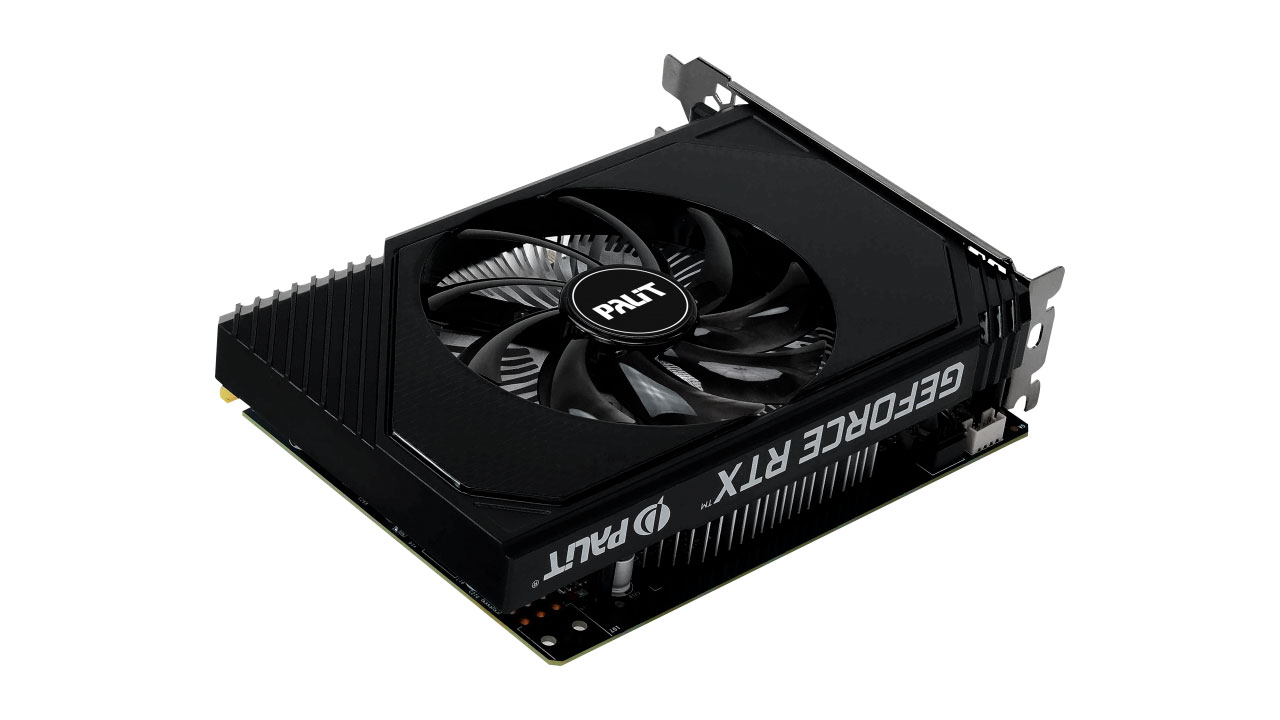Palit brings the DVI port back on Nvidia's budget gaming GPU — RTX 3050 KalmX features a passive cooler and zero power connectors
Palit also managed to bring the DVI port back from the dead!

Palit has built a smaller profile, fanless RTX 3050 KalmX 6GB GDDR6 with reduced VRAM and CUDA cores. Interestingly, this GPU has a DVI port, which is likely for those with older systems and monitors looking for a replacement graphics card. Although the GeForce RTX 3050 6GB can't compete with the best graphics cards, it retains 2nd gen RT and 3rd gen Tensor cores with DLSS, RTX, AV1 decoding, and NVENC encoding/decoding.
Along with the reduced VRAM capacity, the GPU's memory bus is 96-bits. CUDA cores are reduced to 2,048 from the 2,560 typically found in the standard RTX 3050 8GB configuration introduced two years ago. Because of these step-down specs, Palit could get this card's TDP to 70W, which otherwise would be 130W. The only PSU requirement is 300W, with no auxiliary power connectors. Due to the lowered configuration, it shouldn't be surprising that this card will be cool enough for a passive cooler, valid to its sub-branding 'KalmX.'






This GPU is a dual-slot card with HDMI 2.1, DP 1.4a, and dual-link DVI for video output. Palit's RTX 3050 6GB form factor would make it ideal for HTPCs in SFF cases, as it measures 16.3 x 13.7 cm. This probably would be excellent for those who wish to replace aging GPUs like the GTX 950 and GTX 1050 Ti.
MSI also has two new variants, where ComputerBase received the RTX 3050 Ventus 2x 6G OC for a review. The other version is the RTX 3050 LP 6G OC. Both have different coolers and PCB sides, but with 20 MHz clock speed added over the default clock speed while maintaining 70-watt TDP. Based on its initial testing, the RTX 3050 6G loses more than 20% performance compared to the RTX 3050 8G.
This isn't bad since the GPU has significantly reduced TDP and power consumption, which is suitable for the intended audience base that is unlikely to play new (or dated) PC games. German-based Mindfactory also shows it is selling the RTX 3050 6G made by both MSI and Palit from €189 onwards, which is about US$ 204.24, and the cheapest RTX 3050 8G costs € 239.93, viz US$ 259.28. It's safe to say this should be available in other retail channels from respective countries and AICs.
Get Tom's Hardware's best news and in-depth reviews, straight to your inbox.

Roshan Ashraf Shaikh has been in the Indian PC hardware community since the early 2000s and has been building PCs, contributing to many Indian tech forums, & blogs. He operated Hardware BBQ for 11 years and wrote news for eTeknix & TweakTown before joining Tom's Hardware team. Besides tech, he is interested in fighting games, movies, anime, and mechanical watches.
-
ezst036 This is good. There are plenty of solid monitors out there on people's desks that they routinely use that have a DVI connection on the back of them.Reply -
FoxtrotMichael-1 Reply
This is my thought as well. Frequently we as consumers are forced to generate a lot of waste by obsolescence in standards and connectors. Sometimes what you’ve been using for years is still just fine.ezst036 said:This is good. There are plenty of solid monitors out there on people's desks that they routinely use that have a DVI connection on the back of them. -
edzieba The big question is whether this is a true dual-link DVI port, or whether they have just routed the video pins from a HDMI output to a DVI connector to create a mostly-compliant single-link DVI port - i.e. doing what you could already do with a passive adapter dongle but putting that pin rerouting on the PCB.Reply -
JeffreyP55 Reply
Some manufactures found a work around for passing audio through a DVI cable. Be interesting if thing uses it or just optical.Admin said:Palit introduced the RTX 3050 KalmX Graphics card with a reduced CUDA core count and lowered VRAM to 6GB. But as a result, it managed to bring its power consumption enough not to need an external power source or active cooling.
Palit brings the DVI port back on Nvidia's budget gaming GPU — RTX 3050 KalmX features a passive cooler and zero power connectors : Read more -
jlake3 Reply
Part of why DVI went obsolete so fast is because you can passively adapt from either a DP or HDMI source to a single-link DVI monitor. I stuck a DVI male to HDMI female adapter on the back of one of my old monitors, and for something like $6 I can now connect it to any HDMI device. I've got another monitor that has a recessed port where that adpater doesn't fit nicely, and on that one I have a DVI cable with a DP-to-DVI adapter on the computer end, which came in the box with a GPU during the transition period and works with all DisplayPort PCs.ezst036 said:This is good. There are plenty of solid monitors out there on people's desks that they routinely use that have a DVI connection on the back of them.
Palit's webpage does say that this is a dual-link DVI, which would require a more expensive active adapter, but 1440p monitors without HDMI or DisplayPort weren't on the market for that long or wildly common when they were, and you might want a more powerful GPU with an active adapter if you're gaming at 1440p anyway.
And based on other cards, it looks like this came at the opportunity cost of two DP 1.4a ports. -
cyrusfox Reply
Those active adapters never worked for me... I have a catleap 27" 1440p IPS Q270 that only would work with dual-link DVI, sometimes I could get an adapter to work temporarily, but it would always flake out. If I want to use that monitor I need a real DL-DVI port, and sadly most new GPU's omit DVI, I have it running with an old 1070 currently. Once I replace that card though... Its either trying to hunt down a DP upconvert kit or putting it out to pasture unless I can source a GPU with DVI.jlake3 said:alit's webpage does say that this is a dual-link DVI, which would require a more expensive active adapter, but 1440p monitors without HDMI or DisplayPort weren't on the market for that long or wildly common when they were, and you might want a more powerful GPU with an active adapter if you're gaming at 1440p anyway.